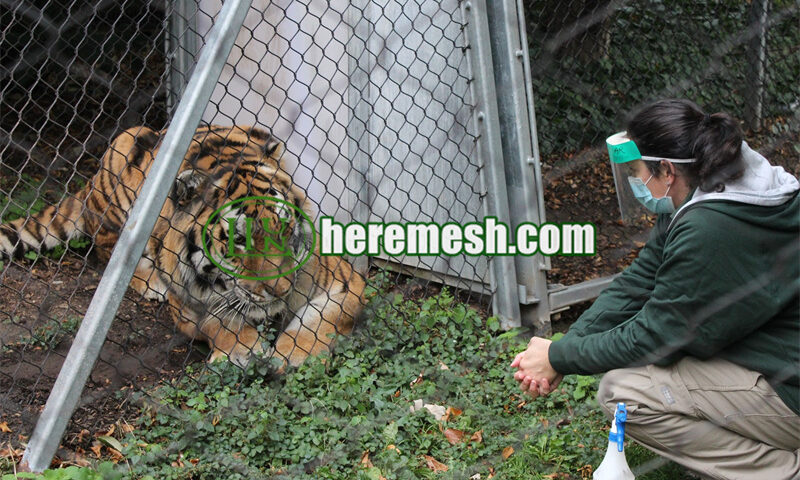Balancing Safety and Ecology: System Design of Tiger Exhibit Fence

Zoo Bird Habitat Solution: Bird Netting Fence Supply for France
10/11/2025
Clear View Flexible Cable Mesh for Animal Enclosures
10/24/2025The fence for tiger exhibits constitutes a critical component of modern wildlife management facilities. It is not merely a physical barrier but a complex technical system integrating safety engineering, animal behavior science, materials science, ecology, and visitor management. This paper aims to systematically elucidate the core functions of tiger exhibit fence and the underlying philosophy of human-nature relations they embody, thereby demonstrating their significance and complexity as a specialized technical field.
Core Functions of the Fence System
Tiger exhibit fence refers to physical barrier installations established within zoos, wildlife parks, and nature reserves to ensure the safe coexistence of humans and large predators. Its core functions can be summarized as follows:
1. Safety Assurance Function: This is the primary purpose of the fence. It must effectively prevent tigers from harming visitors, staff, and surrounding community residents, while also preventing abnormal escapes that could lead to tigers entering unsuitable environments or impacting local ecosystems and societies.
2. Animal Welfare Protection: Modern enclosure design has evolved from mere confinement to ensuring animal quality of life. By providing secure environments, it reduces stress responses and stereotypical behaviors, promoting the expression of natural behaviors.
3. Ecological Isolation and Protection Function: At reserve boundaries, fencing delineates protected areas, reduces human-wildlife conflicts, prevents poaching, and contributes to managing tiger population distribution and movement ranges.
4. Educational and Visitor Support Function: Fence serves as the visual framework for visitors observing tigers. Its design directly impacts viewing experience quality and conveys ecological conservation and scientific management concepts to the public through its form (e.g., concealed fence).
To maximize fulfillment of exhibit area requirements, stainless steel fence design is fundamentally a systems engineering endeavor seeking optimal solutions among multiple objectives.
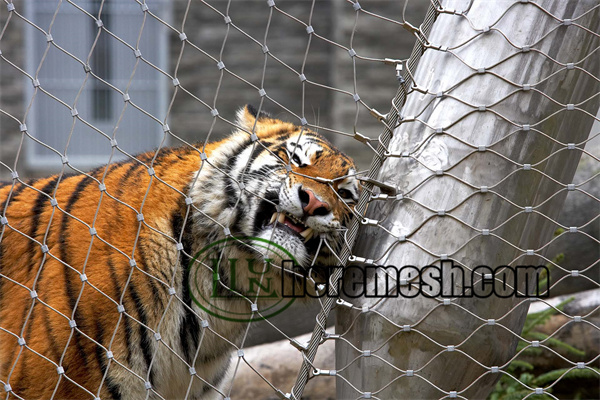
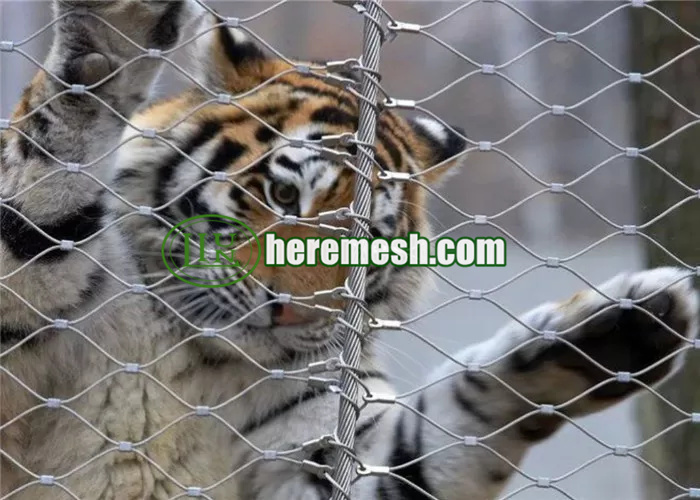
The Development of Tiger Exhibit Fence
The forms and concepts of tiger exhibit fence are not static. Their evolution clearly reflects humanity’s deepening understanding of wildlife and technological advancements.
In early zoos, tigers were viewed as symbols of power or exotic curiosities, with their enclosures designed primarily for display and absolute control. Fencing typically consisted of stone walls or heavy iron cages, constructed mainly from natural stone and cast iron. Spaces were cramped, environments monotonous, and the psychological and behavioral needs of animals were entirely disregarded. The spacing and strength of iron bars were the sole design parameters, leaving animals in a constant state of stress and exhibiting widespread behavioral abnormalities.
With the advancement of animal behavior and ecology, people began to recognize the harm traditional enclosures inflicted on animals. Animal welfare became the core concern of zoological experts. The goal of enclosure design shifted from ‘’building cages’’ to ‘’creating habitats’’. Animal exhibit design now systematically incorporates core elements such as animal behavior, landscape creation, and eco-friendly materials. The pursuit of “concealed” or “naturalized” enclosures aims to minimize the perception of artificial intervention for both animals and visitors while ensuring safety.
Scientific Tiger Exhibit Fence
The material selection and treatment for modern fencing systems are based on in-depth research into tiger physiology, behavioral patterns, and environmental corrosion factors.
1. Primary Materials:
High-strength steel wire: This serves as the mainstream material for the tiger exhibit fence structure. To withstand outdoor humid conditions and animal waste corrosion, stainless steel grades 304 or 316 are selected to prevent rusting. To further extend lifespan and enhance aesthetics, the wire surface undergoes oxidation treatment, forming a dense protective layer. Black is the predominant color to blend with the environment.
For critical load-bearing components or high-corrosion-risk areas (e.g., connectors), 304 or 316 grade stainless steel is recommended. Stainless steel offers superior corrosion resistance and strength.
2. Structural Design
The fence’s structural design is based on precise mechanical calculations of a tiger’s physiological limits.
Height Design: Tigers possess vertical jumping capabilities of 4-5 meters. Consequently, the mesh height of tiger exhibit fence is typically set above 5.5 meters to account for potential climbing attempts using leverage or extreme scenarios. Height specifications are determined not only by physical capabilities but also by the animal’s psychological assessment of risk; excessively high barriers significantly reduce their willingness to attempt escape.
Mesh Shape and Dimensions: Mesh design must prevent any part of a tiger’s body from passing through. Common diamond-shaped mesh more effectively distributes impact loads under stress, offering superior structural stability. Mesh dimensions typically range from 51mm x 51mm to 102mm x 102mm. For exhibits housing both cubs and adult tigers, double-layered mesh or adjustable mesh configurations may be required.
Support Structure: Fence posts serve as primary load-bearing components. They must be deeply embedded in compacted or concrete-poured foundations, typically exceeding 1.5 meters in depth, to resist tiger digging and wind loads.
3. Anti-climb and Anti-dig Design
Top Structure: The enclosure top usually features anti-climb netting inclined inward or outward at 45 to 60 degrees, or incorporates freely rotating rollers. These structures prevent tigers from gaining stable footholds on the top, thereby blocking overclimbing.
Underground Extension: To prevent escape via digging, the underground section of the fence typically extends 0.5-1 meter inward toward the enclosure in an L-shape or U-shape, integrated with ground hardening. In areas with loose soil, a continuous underground concrete wall may be required.
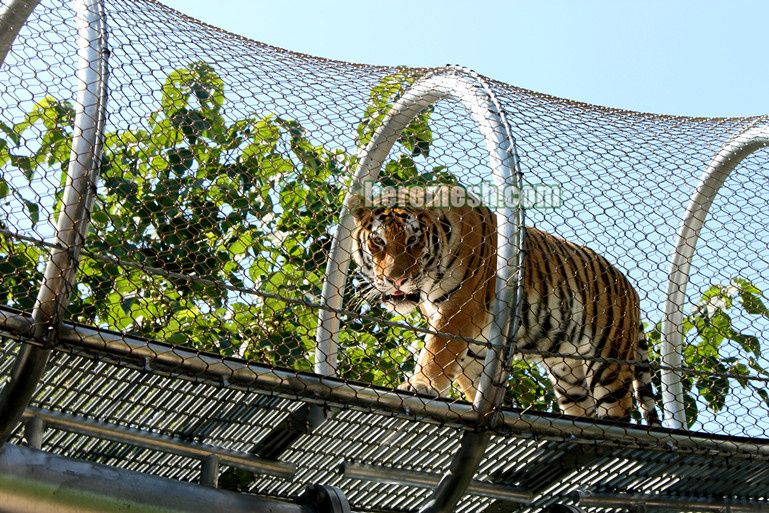
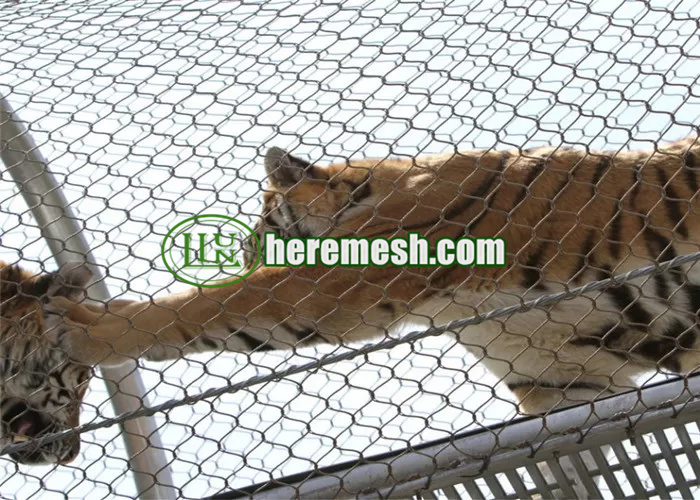
Ecological Tiger Exhibit Habitat
Excellent tiger exhibit habitat fence must consider tiger behavioral patterns and guide them to express natural behaviors.
Completely solid enclosures may cause animals to feel confined and anxious. Modern designs strategically incorporate transparent viewing areas alongside opaque visual barriers, which helps reduce tiger stress. Simultaneously, landscape arrangements provide tigers with spaces for patrolling, hiding, and surveying, fulfilling their territorial behavior needs.
Enclosures are not merely boundaries but integral parts of the habitat. Tiger passageways enable movement between exhibits, expanding the animals’ range and stimulating exploratory behavior. Exhibits should incorporate distinct functional zones such as resting areas, foraging zones, water bodies, and claw-grooming sites. Naturally dividing the exhibit space creates complex spatial structures that replicate wild habitats.
Vegetation integration offers the most natural approach. Climbing plants can be cultivated to cover enclosure surfaces, forming living barriers. Vegetation matching the animals’ natural habitats should be planted within enclosures to recreate authentic survival landscapes. Additionally, placing enclosures along natural topographical features like slopes and ridges utilizes elevation changes to reduce their apparent height. When visitors view from below, the enclosures blend into the skyline. When tigers look down, they perceive sufficient psychological barriers.
Conclusion
The tiger exhibit fence system represents a highly specialized, interdisciplinary engineering solution. Its design integrates knowledge from multiple fields including materials science, animal behavior, and landscape ecology, aiming to balance multiple objectives such as safety, animal welfare, ecological integrity, and educational value.
In the future, with advancements in new materials, enclosure systems will evolve toward greater concealment and enhanced dynamic responsiveness to animal behavior. However, their core principle remains unchanged: creating a safe, healthy habitat where these apex predators can express their natural instincts. In-depth research and continuous optimization of tiger enclosure fencing systems are not merely about technical implementation. They are a vital manifestation of humanity’s commitment to fulfilling its responsibilities in biodiversity conservation.


